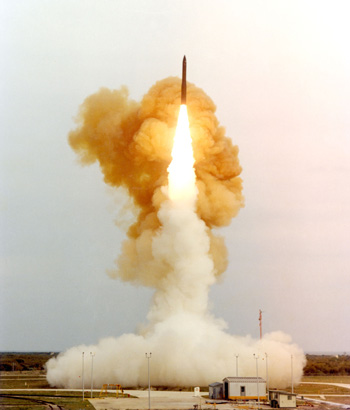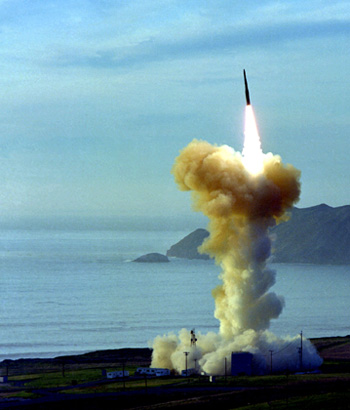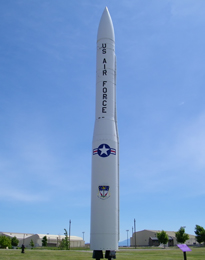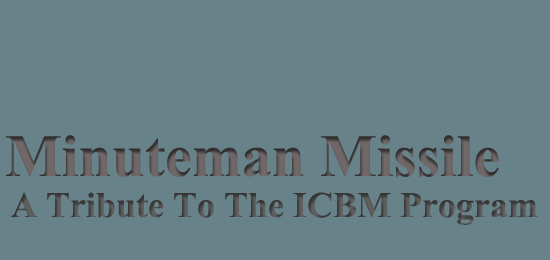
Minuteman III Launch Vandenberg AFB

Minuteman III Launch Vandenberg AFB
Minuteman III LGM-30G Missile
Prior to the Minuteman II missile being deployed and put on operational alert, the Air Force had already invested a lot of time and effort into their research and development of the final version of the Minuteman missile, the LGM-30G Minuteman III.
Boeing's LGM-30G Minuteman III retained the three stages of solid propellant rocket engines. Its first stage booster created 200,000 pounds of thrust, the second stage produced 60,600, and due to its heavier payload, the Minuteman III had a larger third stage booster, which produced 34,000 pounds of thrust.
This missile stands 59 feet 10 inches tall, weighs 78,000 pounds and is 6 feet in diameter at its widest point. The LGM-30G has a range of over 8,000 miles, is capable of achieving an altitude of 700 miles above the earth's surface, and has a maximum speed of 15,000 mph. The unit cost for this missile was $1,818,000.
In its early development stage a significant number of improvements were incorporated into the Minuteman III. One of the key features of these improvements consisted of both the Autonetics and Rocketdyne Divisions of Rockwell joining forces in 1964 to design a post-boost propulsion system that allowed for the correction of the altitude, attitude and velocity of the RV, reentry vehicle, (warhead) after it separated from the third stage rocket booster. This new system was given the title of Minuteman III, and Boeing Aerospace was given the Research and Development contract on July 15, 1965.
Boeing Aerospace's new design used an advanced guidance and control system, a restartable liquid fueled rocket motor, and three Multiple Independently targeted Reentry Vehicles, also known as MIRVs. This new innovative design allowed the Minuteman III to attack three independent targets with a high degree of accuracy.
A number of authors have stated that the MIRV system was a derivative of research into anti-ballistic missile decoys. Others point to the multiple warhead Polaris A-3 missile as prompting the Minuteman III utilizing the MIRV system. The technology used for the new LGM-30G actually came from NASA, based on their launch of a Titan III missile in 1965, which carried four satellites.
The Titan III missile was designed with a restartable transtage motor that allowed for the missile's orbit to be changed so that each of the four satellites were successfully delivered to each individual satellite's orbit.
The advanced reentry system used with the Minuteman III, its payload, consists of a mounting platform, penetration aids to help confuse any defensive systems from targeting the RV as it falls to it target, and a aerodynamic shroud. This shroud protects the MIRVs during its initial stages of launch.
The mounting platform is also referred to as the "payload bus" and consists of a restartable hypergolic rocket engine that is powered by hydrazine and nitrogen tetroxide. With this design, the RVs can be independently aimed at different targets within the missile's overall target area, also referred to as its "footprint." The Minuteman missile had seen a number of significant revisions with each new design, and its latest design that implemented the new advanced reentry system using MIRVs, resulted as quite an achievement.
The MIRV component of the new Minuteman III had advantages to its design that appealed to Congress in a variety of different ways. To some, the multiple warheads that each missile carried would be an effective counter measure to the Soviet Union's planned Anti Ballistic Missile program. To others, the MIRV was a cost effective means of matching the Soviet increase in their nuclear war machine program.
During this period of time the Cold War was continuing to escalate in its intensity, which had all along been a huge driving force in the Air Force's drive to design and build missiles that addressed this pervasive pressure the Cold War carried. The Minuteman III provided the United States' an optimal opportunity to seriously address that ever present pressure with its latest features. Due to these factors the Minuteman III was assured a continued focused effort in its development.
In exploring the design of the LGM-30G in comparison to the Minuteman II LGM-30F, the Minuteman III was basically a Minuteman II missile with a new, larger third stage and a completely different warhead section. As described above, the warhead section consisted of an advanced post boost system, combined with an all new guidance system that controlled the course changes for each RV.
By designing the Minuteman III this way, allowed for the missile to be built in available Minuteman II facilities, which possessed all the tooling and technology already developed and established. This resulted in expedited development which made possible the first flight of the Minuteman III being achieved August 16, 1968. The first silo launch followed 9 months later on April 11, 1969.
The first Minuteman LGM-30G was shipped to Minot Air Force Base, North Dakota and arrived April 14, 1970. It was emplaced three days later. The first flight of Minuteman III missiles was completed by June 15, 1970. On December 29, 1970 Minot AFB was proud to be the first to achieve operational status of a squadron of Minuteman IIIs.
With the completion of the missile wing at Minot AFB, Grand Forks AFB base began its process of rearming its force, starting December 19, 1971. Grand Forks emplaced its first Minuteman III on December 24, 1971. As it emplaced a Minuteman III missile, it displaced its Minuteman II missiles, which were then transferred to Ellsworth AFB in South Dakota. Ellsworth replaced the Minuteman I/Bs with the displaced Minuteman IIs from Grand Forks Air Force Base. The last Minuteman I LGM-30B missile was replaced on March 13, 1973.
FE Warren AFB oversaw deployment of the Minuteman III at its Missile wing starting in November 1972. September 27, 1974 marked the last Minuteman 1B being removed from its silo at FE Warren AFB. Deployment of the final Minuteman III missile was completed on July 11, 1976 with the emplacement of the 550th LGM-30G missile at Malmstrom AFB in Montana.
With the Air Force's continued efforts to improve and build upon the reliability of the Minuteman missile, the proposal was to create a test program and launch eight Minuteman missiles from an operational missile wing. This was partly driven by the test programs involving the Minuteman II missile in the sixties. However, the program was never implemented. Congressmen and Senators from the states over which these missiles would fly nixed the proposal.
Given the resistance the Air Force experienced with these test launches, the closest thing to a "real" launch consisted of a "Glory Trip." A Glory Trip involves the pulling of an operational missile from its Launch Facility from one of the established missile wings, ship it to Vandenberg AFB in California, and then launch that missile from a Launch Facility identical to the one it was removed from. Air Force personnel assigned to their respective missile wings are chosen to experience the honor of traveling to Vandenberg and launching that missile that originated from their assigned missile base.
This has been a tradition since the seventies. Residents who live in the vicinity of Vandenberg are witness to some spectacular launches to this day.

